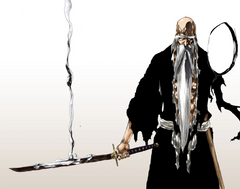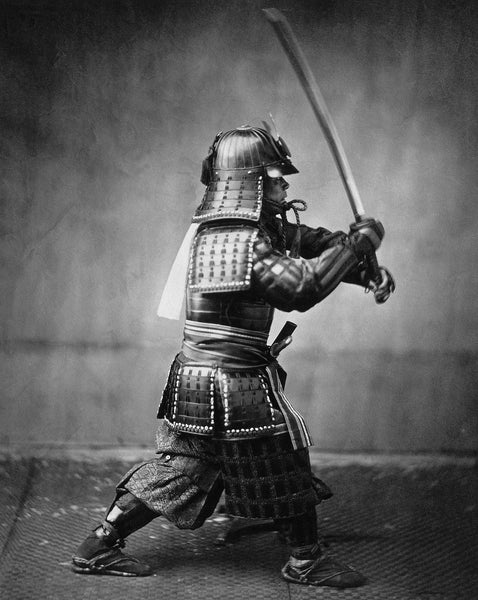There are many Zanpakutō in Bleach, so many that it feels like a momentous task to come up with a top 5. However, we feel we owe it to our readers to provide our reasons for why we consider the following swords the best in Bleach. Of course, this list is subjective, and you may feel differently. That’s ok! But read along for our rationale of why we consider the following 5 Zanpakutō to be the best.
To make it interesting, we will judge using four main criteria. While power will definitely be one of them, it won’t be the only one. Other criteria include usefulness in various situations, the psychological edge over opponents it creates, and the appearance of the ability (how “cool” it looks).
Special Mention

While not one of the 5, we feel Ichigo Kurosaki’s Zanpakutō Zangetsu deserves an honorable mention. First, while it was never revealed what form its Bankai takes, it was considered so powerful by Yhwach that it was disabled immediately before it could be used. Second, because it produces energy blasts that can be directed and controlled, it is useful in many situations. Finally, it is one of a few Zanpakutō that remain in a state neither fully-sealed nor fully-unsealed, leaving it with two blades, making it immediately recognizable to opponents and unique. However, Zangetsu does not make the list because we do not know the full extent of its abilities, and we feel its abilities, while indeed powerful, are overshadowed by the others in this list.
#5

Kisuke Urahara’s Zanpakutō takes #5 on this list. In its sealed state, Benihime takes the form of a cane rather than a normal Katana. It is one of the few Zanpakutō with a spirit of the opposite gender as its wielder. Like Ichigo Kurosaki’s blade, its Shikai can fire energy blasts. However, its Bankai form has a completely different ability, allowing Kisuke to restructure anything he touches with Benihime. While the exact limits of this restructuring are unknown, it is able to restore vision to wounded eyes and manipulate things in Kisuke’s path to remove obstacles. Its abilities may be limited primarily by Kisuke’s own imagination. Fulfilling all 4 criteria, it makes the list, albeit barely.
#4

Gin Ichimaru’s Zanpakutō comes in next to take the #4 slot on the list. While simple in form and appearance, Shinsō has the ability to extend up to 100 times its length when released, and much further in its Bankai form (up to kilometers). However, the length is only a small part of what makes this ability so useful. Shinsō can extend and contract faster than a bullet, allowing Gin to impale his targets with ease and push people out of the way of falling objects. Its cutting ability is also greatly amplified, making slashing attacks deadly as the Area-of-Effect of the swath is incredible - once literally slashing a town in half while Gin stood some distance away. Furthermore, the sword can turn to ash for a split second when contracting or extending, leaving a piece of itself inside the momentarily impaled and future victim. From then on, whenever Gin chooses, he can kill his target at will, simply by raising his hand and uttering a few words. The target will then dissolve from the inside out. While perhaps having a bit less utility then #4, the sheer coolness factor of Shinsō’s abilities and the challenge of using them to their fullest potential means we put it a spot above Benihime.
#3

Byakuya Kuchiki’s Zanpakutō is a normal Katana that, when released, separates into a thousand small fragments that move around, directed by Byakuya’s will through the motions of the hilt remaining in his hand. Each fragment carries the power of a full sword and reflects light in such a way as to resemble a cherry blossom. While perhaps not as powerful as the previous Zanpakutō, Senbonzakura is balanced as much for defense as offense. Any opponent attempting to get close is liable to be cut by the fragments, and only Byakuya himself is immune, as he stays in a “Hurtless Area” where the sword fragments are not allowed to enter. Its Bankai is even more powerful, instead of a thousand fragments, it has a thousand full swords that he can control. With both abilities, Byakuya can form constructs that can take many shapes using the fragments or swords, which greatly amplifies the abilities’ usefulness. What really takes the cake, however, and gives Senbonzakura the middle-spot on this list is the following. Not only can the Zanpakutō’s power be further increased by combining the fragments back into a single sword with an insane amount of power, but it can also grant Byakuya wings with which he can fly!
#2
Perhaps unsurprisingly, Ryūjin Jakka, the Zanpakutō of Genryūsai Shigekuni Yamamoto, takes the next slot in the list. In its sealed state, it has the appearance of an unassuming staff, though even in this form most Shinigami are still afraid of it because of its immense power. Unsealed, it looks like a normal Katana, albeit with flames surrounding it. Genryūsai can burn almost anything to ash just by waving his sword at it, and in this form it is powerful enough to fight the Shikai of two other captains simultaneously. A very useful feature of the weapon is that when it is resealed, any ability already used against an opponent does not end. Its Bankai form stores the flames inside the blade, causing anything it touches to be reduced to ash, and also removes any water from the surroundings, rendering any ice-type Zanpakutō nearby useless. Furthermore, Gen ryūsai can use raise an undead army from the ashes or corpse of anyone he has killed, making him more and more powerful as a battle progresses. The only weakness of this sword is that it is so powerful that it could obliterate soul society if used for a an extended period of time, but because it’s so powerful, it would never be needed to. With unmatched power, coolness (hotness?), and ability to have its enemies fight for it, Ryūjin Jakka deserves a spot high in this list.
ryūsai can use raise an undead army from the ashes or corpse of anyone he has killed, making him more and more powerful as a battle progresses. The only weakness of this sword is that it is so powerful that it could obliterate soul society if used for a an extended period of time, but because it’s so powerful, it would never be needed to. With unmatched power, coolness (hotness?), and ability to have its enemies fight for it, Ryūjin Jakka deserves a spot high in this list.
## 1
Finally, the one we’ve all been waiting for - what we consider the #1 Zanpakutō in Bleach. This honor we give to Ichibē Hyōsube’s Zanpakutō Ichimonji. In its sealed state, it appears as a functional calligraphy brush. In this form, it can be used to draw characters that have the power of their meaning. When used as a weapon, the brush cuts the name of what it touches, reducing its power accordingly. When released, it transforms into a short glaive that releases ink as its swung. Whatever this ink touches loses its name and consequently, all its powers. However, its true power comes from its ability to control black - anything with black on or inside it is vulnerable. This power seems to have no range limit. Ichibē can use this power to draw black from his surroundings, and, by drinking it, take away all the darkness from an opponent, leaving nothing of his opponent left. As the first Zanpakutō to achieve Bankai (before the name “Bankai” even existed), Ichimonji has the distinction of being the only Bankai activated with a different word - “Shin’uchi” In this form, it becomes a long white thread. Anything touched by its Ink can have it named changed, giving it the powers or abilities (or lack of abilities) of the new name. This makes Ichimonji the most powerful, useful, and unique Zanpakutō in existence, as there is practically nothing it can’t do, especially considering that Ichibē himself can determine the true name of everything in existence, and has centuries of experience to draw upon.
Summary
Regardless of whether you agree with our ranking or not, one thing we can all agree on is that Zanpakutō are awesome! We carry many Bleach Swords besides these, including some that may have made your list.
Image Credit: Bleach.wikia.com
source https://www.bladespro.co.uk/blogs/news/top-5-zanpakuto-bleach


